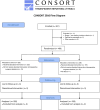Dural Tenting in Elective Craniotomies: A Randomized Clinical Trial
- PMID: 40310111
- PMCID: PMC12507126
- DOI: 10.1227/neu.0000000000003480
Dural Tenting in Elective Craniotomies: A Randomized Clinical Trial
Abstract
Background and objectives: Dural tenting sutures are a well-known neurosurgical technique. However, claims of them preventing extradural hematomas (EDHs) lack evidence-based support. For that reason, we decided to evaluate the noninferiority of routinely not tenting the dura in elective supratentorial craniotomies.
Methods: A randomized, multicenter, investigator-blinded and participant-blinded, controlled interventional trial with 1:1 allocation. We included adults undergoing elective, supratentorial craniotomies. Not tenting the dura was an intervention, and the control group consisted of patients with at least 3 dural tenting sutures. The primary outcome was the risk of reoperation because of EDH, and secondary outcomes included a selection of clinically relevant outcomes.
Results: We randomized 490 patients into intervention (238, 49%, not tenting the dura) and control (252, 51%, dural tenting) study groups, as per intention-to-treat analysis. Proportions of EDH surgeries in the intervention group were noninferior in comparison with the control group and not significantly different using the intention-to-treat (0.8% and 0.4%, P = .98), per-protocol (0.5%, 0.4%, P > .99), and as-treated (0.5%, 0.7%, P > .99) analyses. There were no significant differences in secondary outcomes: postoperative 30-day mortality (0.8%, 1.2%, P > .99), postoperative 30-day readmission (1.7%, 4.4%, P = .99), new neurological deficit or deterioration of a previous (19.7%, 15.5%, P = .81), cerebrospinal fluid leak (1.3%, 4.4%, P > .99), deterioration of postoperative headache over 5 numerical rating scale (4.4%, 2.4%, P = .85), epidural collection thickness over 3 mm (90.8%, 87.3%, P = .81), and midline shift over 5 mm (7.6%, 4.8%, P = .791) in the intervention and control study groups in intention-to-treat analysis. Similarly, secondary outcomes were not different in per-protocol and as-treated analyses. Other than cerebrospinal fluid leaks and EDHs, there were 17 adverse events in the intervention group and 19 in the control group (intention-to-treat analysis, 7.1% and 7.5%, respectively).
Conclusion: This trial demonstrates the noninferiority of omitting prophylactic dural tenting for postoperative EDH requiring surgery in elective, supratentorial craniotomies.
Trial registration: ClinicalTrials.gov NCT03658941.
Keywords: Craniotomy; Dural tenting sutures; Extradural hematoma; Randomized clinical trial.
Copyright © 2025 The Author(s). Published by Wolters Kluwer Health, Inc. on behalf of the Congress of Neurological Surgeons.
Figures
References
-
- Dandy WE. Surgery of the Brain. Prior; 1945.
-
- Swayne OBC, Horner BM, Dorward NL. The hitch stitch: an obsolete neurosurgical technique? Br J Neurosurg. 2002;16(6):541-544. - PubMed
-
- Winston KR. Dural tenting sutures in pediatric neurosurgery. Pediatr Neurosurg. 1998;28(5):230-235. - PubMed
-
- Winston KR. Efficacy of dural tenting sutures. J Neurosurg. 1999;91(2):180-184. - PubMed
Publication types
MeSH terms
Associated data
Grants and funding
LinkOut - more resources
Full Text Sources
Medical


